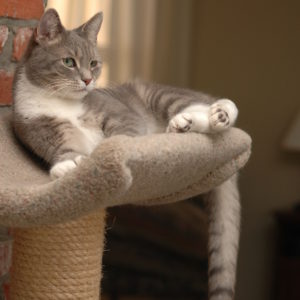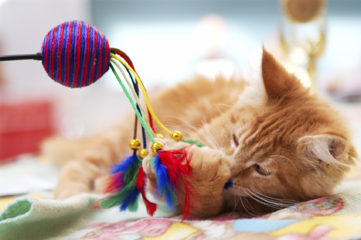
Congratulations on adding a new cat into your home! Now it’s time to make sure you are prepared and have the “basic necessities” for your cat’s transition into your home. Here’s a list of some basic supplies your new feline friend will need:
Cat Food
Ask your veterinarian which food would be best for your cat, or buy a small amount of what your cat is currently eating and then consult with your veterinarian. Once you find a good quality cat food, suitable for the age of your cat, stock up and offer it daily.
Food and Water Bowls
Provide your cats with a food dish and a water dish that are wide and shallow. Please remember to provide your cat with fresh food and water daily. Some cats prefer a glass dish instead of a plastic one or drinking running water, such as from a water fountain.
You may want to offer multiple bowls of water throughout your house where your cat can get a drink of water. If your cat is part of a multi-cat household, it is important to provide several feeding stations. These water and food stations should be located away from litter boxes.
Cat Scratching Post or Cat Tree
Scratching is a natural behavior for cats, so it’s very important to include an acceptable place (or places) for scratching in your home. There are many options available such as scratching posts, cat trees, and cardboard scratching boxes. Find out which your cat prefers texture-wise, as well as whether he prefers a vertical or horizontal scratcher.
The placement of scratchers is very important. Cats often stretch or scratch when they wake up, so try placing one near where your cat sleeps. It may also be helpful to place a scratcher near or in front of a cat’s preferred, yet undesirable, scratching object (e.g., corner of the couch).

Toys
It’s good to have a variety of toys available so your cat has something “new” to play with each day. Have some fun, appropriate toys your cat can play with on their own and with you. Toys encourage physical and mental stimulation and allow your cat to use its natural hunting and stalking behaviors. Cats prefer toys that change in texture and shape as they are played with, mimicking the stalk, grasp, and kill behavior of prey. If your cat seems to become “bored” with a toy, it may be because it doesn’t change when they play with it. Interactive toys like “fishing poles” or feather wands are especially fun when you have playtime together. Some toys with strings or loose parts may need to be put away after play so your cat stays safe.
Litter Box
A large litter box is ideal for urination and defecation. The litter box should be one-and-a-half times the size of your cat. This lets them have enough room to enter, turn around, scratch, and eliminate. Low storage bins or totes can make great litter boxes. Most litter boxes are made of plastic, which makes them porous and able to pick up odors readily.
Litter boxes should be replaced at least once a year. If you have multiple cats, the number of litter boxes should be one more than the number of cats in your household. Make sure you place the litter boxes on different levels or in different rooms in multi-cat households. Avoid placing the boxes right next to each other because cats often see them as one large litter box instead of multiple litter boxes.
If you have older cats, they may need a litter box with a lower opening. This allows them to easily climb in and out of the box. Also, place the older cat’s litter box on the level in your home where they spend most of their time. Interested in learning more about litter boxes? Here is everything you need to know about litter boxes.
Cat Litter
Most cats develop a preference for a kind of litter when they are kittens. The texture of the litter has importance because the pads on cats’ feet are very sensitive to touch. Most cats prefer an unscented, clumping litter. You may need to try multiple kinds of litter to find out which kind your cat prefers. If you have an older cat or a cat with sensitive paws, avoid litter with a sharp or very hard consistency.
Litter Scooper
It is important to have a sturdy scoop to clean out fecal matter and urine balls every day. Metal scoops are recommended to plastic versions as they tend to be more durable. Waste material collected daily from the litter boxes can be kept in a trashcan liner (bag) and put out with the trash.
Cat Nail Clipper
Regularly trimming your cat’s nails can prevent injury and damage to household items. Ask your veterinarian what type of clipper is best for your cat. You should also ask for a demonstration on how to trim your cat’s nails.
Bed
Most cats enjoy soft, cozy beds with deep sides they can settle down into. These beds provide cats with safe places to rest and sleep.
It is helpful to have multiple resting places since cats seek warmth throughout the day. They will move to different parts of the house where the sun is shining through the windows. Homes with multiple cats should have a variety of beds in many locations so cats can have their own space if they choose.
Metal Cat Comb
Many cats like to be brushed and most cats have a preference for the type of tool used. There are a wide variety of good brushes and gloves available. It is especially important to find an acceptable tool for long-haired cats that may have trouble “keeping up” with their coats. It may be easier to start grooming your cat as a kitten. If your cat does not enjoy being brushed, start slowly, and give your cat plenty of breaks.
Cat Toothbrush
It is very important to brush your cat’s teeth since dental disease is very common in cats. Ask your veterinarian about what type of toothbrush you should use on your cat’s teeth. If you start when your cat is young, brushing can become something your cat will allow. You should brush the outside surfaces of your cat’s teeth and make sure to reward them afterward.

Cat Collar and Tags
All cats should have a collar and identification tag, even if your cat stays indoors. The collar helps to identify your cat if they escape from your home or while at the veterinarian’s office. You can attach the rabies tag to the collar. Ask your veterinarian or veterinary staff for help putting the collar on tightly enough that it will not be lost.
Microchip
It is recommended to have this permanent form of identification implanted at your veterinarian’s office. It offers the best chance of finding your cat if they ever get out or become lost. Make sure to regularly check the information on file about you and your cat. Update addresses and phone numbers as they change.
Your individual cat may need additional resources. Discuss these items with your veterinarian, as well as additional supplies your cat might need.
Contributed by Dr. Paige Garnett, DVM

